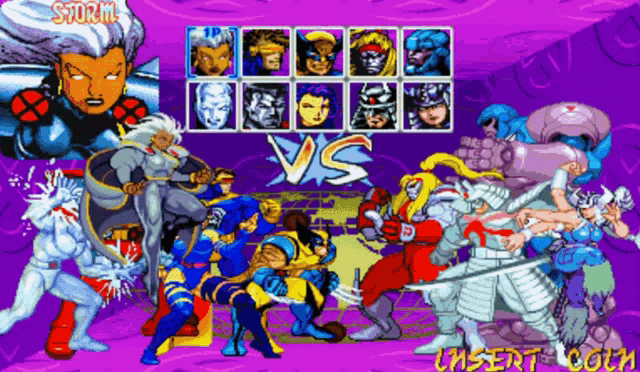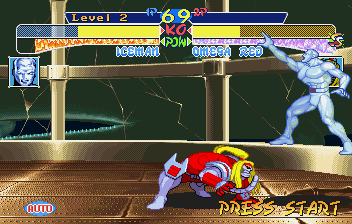X-Men:
Children of the Atom

STORY:
The
game's plot is loosely based on the "Fatal Attractions" storyline. The
main antagonist is Magneto, who plans to unleash an electromagnetic pulse on the
Earth that will disrupt the magnetic fields and create havoc on the world's
electrical systems ushering in a Dark Age for Earth's non-mutant population.
With the promise of a mutant-run planet, the X-Men's most formidable foes join
forces with Magneto.
REVIEW:
Capcom appealed to both arcade fighting game
fans and Marvel fans by turning Marvel's trademark X-Men franchise into a
beautifully-inspired 2D fighting game — one of the best-looking to date, in
fact! X-Men: Children of the
Atom allows you to play as
several heroes and villains from the iconic X-Men series, who battle it
out in a variety of locations based on the comics and X-Men animated TV
series. The game further cemented its authenticity by
using the original voice actors from the X-Men animated
series, such as Cathal Dodd as Wolverine!
|

|
|
X-Men:
Children of the Atom character select screen.
|
Right off the bat, you notice X-Men: Children
of the Atom is eye-catching and visually leagues above many other fighting
games at the time. In motion, Children of the Atom shines even more.
Marvel's iconic characters were given superb
animation by some of Capcom's best 2D sprite artists and illustratos. The way characters throw their
attacks and dramatically take damage was a certainly a milestone, and no doubt a new
benchmark to how 2D fighting game animation could be handled in a fighting game.
Not only was X-Men: Children of the Atom one of the best-looking and hardest hitting 2D
video games upon its arrival; the gameplay was also incredibly innovative,
offering several brand new
ideas to fighting games.
|

|
|
Huge
super moves. . . Enter a new era of 2d fighting!
|
Naturally, the gameplay foundation of X-Men: Children of the Atom takes
many inspirations from Capcom's Street
Fighter 2 series. The "X-Power" gauge functions similarly
to the Super combo gauge from Super
Street
Fighter 2 Turbo as well as the
"Special" Gauge from Darkstalkers.
Players can then perform an "X-Ability", which consumes a small
portion of the X-Power gauge, or a "Hyper X", which consumes a greater
portion of the same gauge. Breaking one's fall from a throw or performing a
counter-throw will also consume a portion of the X-Power gauge when performed.
Soon to become a staple in Capcom's Marvel Vs. series... X-Men:
Children of the Atom introduced Super
Jumps for the first time in a fighting game, allowing characters to jump way
higher than in traditional fighting games and continue fighting air. (Normal jumping is also allowed, as being able to mix up the height of
your jumps is a great new gameplay strategy.) Super Jumps promote aerial combat
complete with air projectiles (which makes perfect sense in a superhero fighting game) and
highlights the game's incredibly fast-paced,
frantic gameplay which includes huge multi-hit air-combos. Big special moves, flashy super moves, and insane combos
were other noticeable features that X-Men: COTA introduced.
Other features introduced in Children
of the Atom include the ability to roll away or towards an opponent after
falling, and the ability to charge an opponent after throwing them for follow-up
attacks. To make it easier for new fighting game players, the options of
"Manual" or "Automatic" (blocking) are available after selecting
a character. By selecting to automatically block attacks, certain features are
not available during gameplay.
|

|
|
Akuma
appears as a secret character. . . a sign of the future!
|
Capcom's original contract with Marvel
stipulated that Capcom can include a character from the Street Fighter
franchise in X-Men: Children of the Atom. As one of the first-ever "crossover / guest" characters
to appear in a fighting game, Street Fighter's Akuma
himself makes a appearance as a secret unlockable character
(playable after inputting a secret code). This was indeed a monumental crossover
at the time, reminding arcade-goers that Street Fighter was certainly
here to stay and still making huge innovations in the genre. Several cameo characters also appear
in some of the character endings, including: Professor X, Forge, Phoenix, and Mojo.
|
|

| Page Updated: |
August
1st, 2025
|
| Developer(s): |
Capcom |
| Publisher(s): |
Capcom
Acclaim  Console Console |
| Artwork
by: |
Akiman
Kinu Nishimura
CRMK |
| Platform(s): |
Arcade, PlayStation, Sega Saturn, PC
|
| Release Date(s): |
December 1994
 Arcade Arcade
January 1995
 Arcade Arcade
Nov. 22nd, 1995
 Saturn Saturn
1996  Saturn Saturn
Apr. 6th, 1996
 Saturn Saturn
May 31st, 1997  PC PC
February 1998
 Saturn Saturn
Mar. 3rd, 1998
 PS1 PS1 |
| Characters: |
Cyclops,
Wolverine, Storm,
Iceman,
Colossus,
Psylocke, Sentinel, Spiral,
Omega
Red, Silver
Samurai, Juggernaut,
Magneto, Akuma |
| News
Links: |
July
2025: UDON Announces MVC: Ultimate Complete Works |
|
|
|
Featured Video:
|
|
|
| Related Games: |
X-Men
Vs. Street Fighter, Marvel Super Heroes, Marvel Super Heroes
Vs.
Street Fighter, Marvel Vs. Capcom, Marvel
Vs. Capcom 2, Marvel Vs. Capcom 3, Ultimate
Marvel Vs. Capcom 3, MVC: Infinite, Marvel
Vs. Capcom Fighting Collection, Justice
League: Task Force, King of Fighters '94, Samurai
Shodown 2, Golden Axe: The Duel, Darkstalkers,
Tekken, Virtua Fighter 2, Super
SF2 Turbo, Galaxy Fight |
|

|
|
Gameplay
Engine
|
8.5 / 10
|
|
Story
/ Theme
|
10 / 10
|
|
Overall
Graphics
|
9.5 / 10
|
|
Animation
|
10 / 10
|
|
Music
/ Sound Effects
|
8.5 / 10
|
|
Innovation
|
9.0 / 10
|
|
Art Direction
|
9.5 / 10
|
|
Customization
|
5.0 / 10
|
|
Options / Extras
|
6.0 / 10
|
|
Intro / Presentation
|
7.5 / 10
|
|
Replayability / Fun
|
7.5 / 10
|
|
"Ouch" Factor
|
8.5 / 10
|
|
Characters
|
8.0 / 10
|
|
BOTTOM LINE
|
8.8
/
10
|
|
Review based on Arcade
version
|
|
| Final
Words: |
X-Men: COTA was unquestionably an innovative and influential 2D fighting
game both visually and technically, spawning the VS Series gameplay
system which would be used in many future Capcom fighting games. Visually, it
put many other 2D fighting games to shame, especially certain console-only
fighting games (Justice League: Task Force would be one of them).
The only thing holding the game back from perfection were some gameplay
imperfections and exploits. For one, players could not select the same character
- a frustrating quirk for competitive players. One of the only other notable flaws is the somewhat small character roster. No doubt, die-hard Marvel fans could only
ask for more X-Men and Marvel characters to be represented.
A few
years later, Capcom answered with
Marvel
Super Heroes and X-Men Vs. Street Fighter, which added even more
beloved Marvel icons. The sequels further refined and fleshed out the aerial
combo system as well, making for even more enjoyable and playable Marvel
fighting games.
~TFG Webmaster | @Fighters_Gen
|
|
|
|
|
|
|
|
|
|
|
|
|